

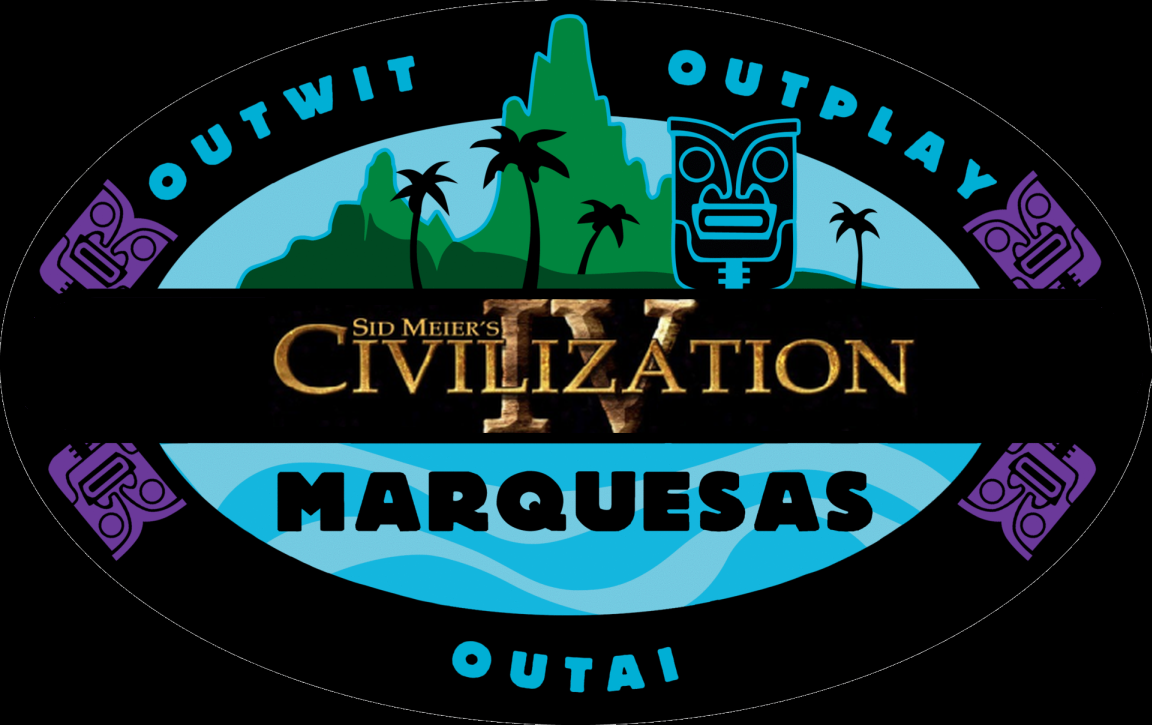
We had a clear theme for Game Four of AI Survivor: religion, religion, and more religion. Five of the seven leaders in this game started with Mysticism tech and would have an opportunity to found one of the game's opening two religions. This was a stark contrast from Game Three, where none of the six leaders began the game with Mysticism and we had no idea where the religions were going to fall. Heading the group as the protected Pool 1 leader was Justinian, the champion of Season One of AI Survivor, and one of the most consistently dangerous competitors in this event. We wondered whether the removal of the free Deity starting techs would hurt him due to Byzantium's poor default combination of Mysticism/Wheel, or if he would simply power on through regardless. The other protected Pool 2 leader was Suryavarman, one of those rare leaders with low peace weight and good economic traits. His best showing had also been in Season One, and the Khmer had underachieved a bit since then. As for the rest of the group, almost everyone wanted to get their hands on a religion in some way. Asoka, Charlemagne, and Saladin were all likely to chase after the opening faiths regardless of the consequences and quite likely to their own detriment. Finally, we also had an aggressive leader in the form of Peter to shake things up... and the game's most insane warmonger in Montezuma to boot. What lunacy would Monty get himself into in this game?
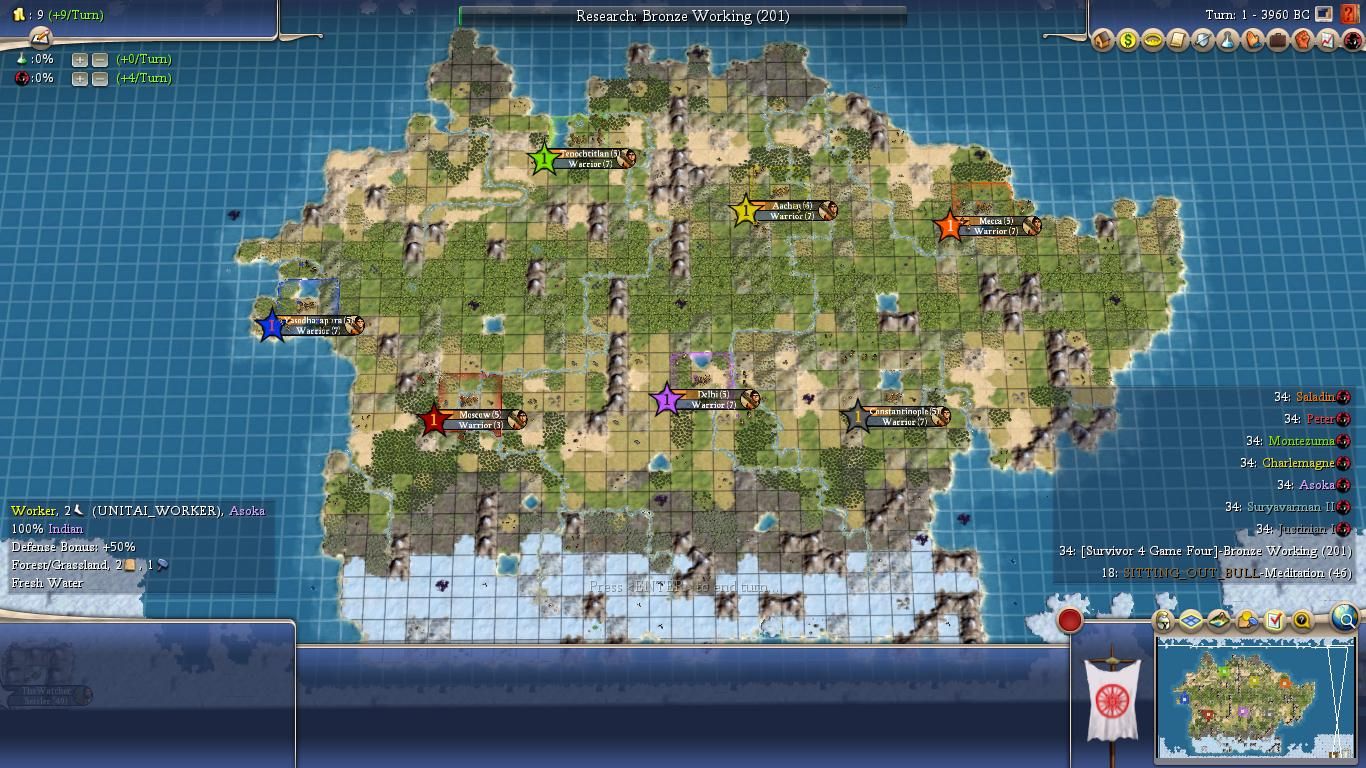
The religious race was on in earnest from the start of the game, with all five of the Mysticism leaders going after the initial two faiths. Justinian narrowly won the competition to Meditation, beating out Charlemagne by a single turn, and he immediately founded his preferred religion of Christianity. There was a three-way race for the Polytheism religion taking place at the same time between Asoka, Montezuma, and Saladin. The Indian leader managed to land this second religion and established Buddhism, immediately creating a situation where the first two faiths were bordering one another at the bottom of the map. That did not appear to bode well for Asoka, who now had another potential enemy on his eastern flank in addition to all of the low peace weight civs to his north and west.
Fortunately for their own sake, none of the AI leaders were dumb enough to ignore all of the initial worker techs in favor of a push to the third religion at Monotheism. It would take a little while before anyone ventured there. The early turns were therefore spent doing the usual stuff of improving the first tiles at the capital and pushing out settlers onto the map. Justinian was doing a particularly good job of this, making use of the wet corn and gold resources at his capital, and Peter also connected his starting resources at an early date. They were both doing well at expanding out onto the map, although Peter did the weird thing where an AI skips Mysticism tech and spent the first 80 turns of the game with no expanded borders outside of his capital. Asoka was not expanding very well at all, opting instead to stick on three cities and construct the Oracle, but at least he did take a useful Monarchy tech and open up his Buddhist shrine via the resulting Great Prophet. Justinian pulled a similar and more effective move by landing Stonehenge a little bit later. Eventually we did get the third religion, a surprising Confucianism from Montezuma:

Monty wasn't doing very well at this point, sitting in last place on the scoreboard. He had inexplicably refused to research Animal Husbandry tech despite having horse and sheep resources at his capital - typical Montezuma. This naturally resulted in the Aztecs lagging in expansion, and together with Suryavarman also struggling to expand for no clear reason, had left a large gap of open territory on the western side of the map. Peter would end up filling much of that land with his own Russian cities, providing an opportunity for him to climb the scoreboard and become one of the major powers. I thought that Montezuma's new religion might end up having free reign over the western side of the map, but it turned out that he did a poor job of spreading it around. That's another problem with Monty, as he tends to do nothing but train units and doesn't spend enough time on infrastructure or religious/cultural stuff. This would end up creating an opportunity for other leaders to spread their own religion to the godless civs in the west.
Over the following turns, we began to see the religious landscape of the game take shape as the map filled up with cities. It was obvious before the game started that religious diplomacy was going to be hugely important in this contest, and the leader that could line up the most religious partners would have an inside track to the victory. Justinian had the most initial success in this regard, as his Christianity spread to Charlemagne and gained a first convert on Turn 47. This was a natural result of the two of them sharing the same river connection and was probably inevitable. The next conversion was a total shocker though: Suryavarman also converted to Christianity on 63! What the heck - how did that even happen?!  It was a natural spread that apparently took place via the seaborne connection that ran around the outside of the pangaea. Needless to say, this was a pretty crazy result from an RNG perspective and it would end up having substantial effects on the game's diplomacy. Justinian had managed to find an ally over in the west without really trying.
It was a natural spread that apparently took place via the seaborne connection that ran around the outside of the pangaea. Needless to say, this was a pretty crazy result from an RNG perspective and it would end up having substantial effects on the game's diplomacy. Justinian had managed to find an ally over in the west without really trying.

The map was getting close to full by Turn 67 and we were watching to see where the first wars would break out. Justinian and Peter had done the best in the landgrab phase of the game, and if they could consolidate their holdings they were likely to be the major powers. Charlemagne had also done reasonably well, although his two southern cities were crushed by Indian culture and didn't control most of their own tiles. Suryavarman had recovered a bit from a very slow start and looked to be OK if he could capture those barbarian cities to his north. It was Asoka and Montezuma who were in the worst shape, Monty because he hadn't expanded enough and his economy was in terrible shape, and Asoka because everyone hated him. Yes, there was a reason why Asoka was picked as "First to Die" by about 70% of the entrants in the picking contest. He had a high peace weight in a game of mostly aggressive characters, and he also established a self-founded religion that no one else practiced. Rather than spread his religion, Asoka continued to plant an even larger bull's eye target on his backside by constructing a series of tasty wonders like the Pyramids. Not the best decision there.
The first war was delayed for a long time in this game. We were approaching Turn 100 and still no one had launched an invasion yet. There were lots of "Annoyed" faces in the diplomacy so it had to be only a matter of time. When the first war started, it came from an unlikely source:

In a game with Montezuma and Peter and Charlemagne, it was instead Asoka who kicked things off with the first attack. That was... unexpected, and not a smart move. Asoka's diplomatic situation was terrible and he was making things much worse for himself by opting into a conflict with one of his powerful neighbors. Even worse, Peter already had an early Construction tech finished and could build catapults to remove the cultural defenses from Asoka's cities. This would avoid the stalled out warfare that we typically see from early invasions and instead proceed onwards to the city capturing phase. Making matters worse, Suryavarman declared war on Asoka three turns later and joined the fray, capturing the city of Pataliputra for himself. There would be one Khmer city in the middle of the map at this one spot for a long time afterwards. That reduced Asoka to a mere four cities and appeared to signal the beginning of the end for him.
Elsewhere in the game, Justinian was quietly developing his civ and building up an alliance of Christian partners. He had already converted Charlemagne and lucked into a conversion of Suryavarman, and now Saladin was the next target, with Arabia flipping over to Christianity on Turn 98. We kept an eye on Justinian to see if and when he might join the war against India as well. Up in the north, Montezuma launched his first invasion of the game against Charlemagne on Turn 111. These two would largely fight to a stalemate over the next two dozen turns, each one capturing a border city from the other and otherwise no major territory changing hands. Meanwhile, the walls were closing in on Asoka as the Byzantines did eventually join the larger war to the south:
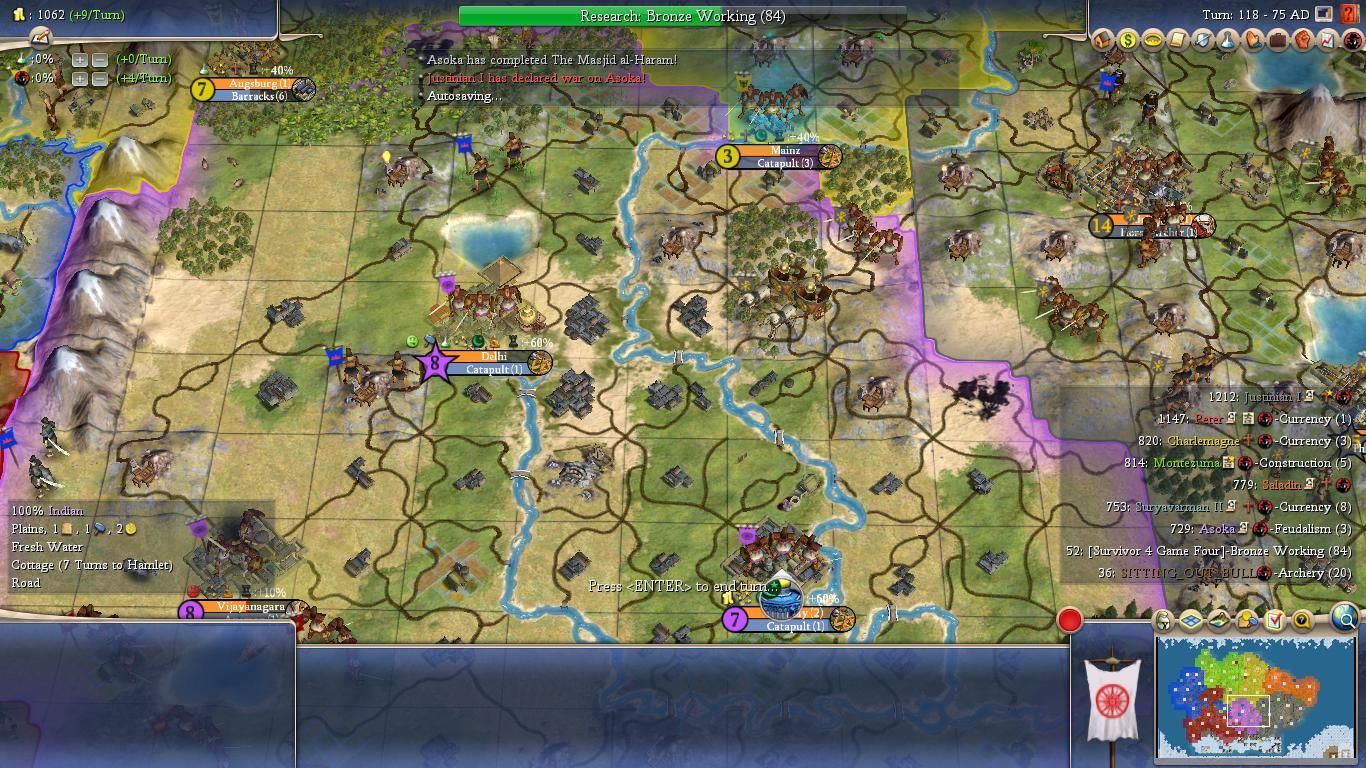
It was a smart read on the larger game situation by Justinian, taking this opportunity to grab territory from Asoka who was all but dead at this point. The three core Indian cities in this screenshot all had valuable prizes inside. Delhi had five or six different wonders (including Shwedagon Paya, Great Library, and Hagia Sophia) while Bombay contained the Buddhist and Islamic shrines. Not to be outdone, Vijayanagara off to the west was the location of the critical Statue of Zeus. It was going to be very important indeed as far as whether Peter or Justinian captured these highly valuable Indian cities.
Peter had one key edge here: he had catapults while Justinian still lacked Construction tech. As a result, the Russians were able to siege down Asoka's cities and remove their considerable cultural defenses while Justinian was left beating his head ineffectually against the Indian walls. First Peter took Vijayanagara, then the big collection of wonders at Delhi. We thought that Justinian would at least be able to take Bombay and its double shrines right on his border, but no, the attack there came up short and had to limp away to regroup. Although Justinian was looking really strong in this game, with his own highly profitable Christian shrine and now the powerful Apostolic Palace wonder to boot, he was going to need to pick up some more land somewhere if he wanted to win the game. He appeared to be in the process of flubbing away an ideal chance to devour up some prized Indian real estate. In the end, Peter took every Indian city aside from that initial Khmer capture and claimed the kill credit:
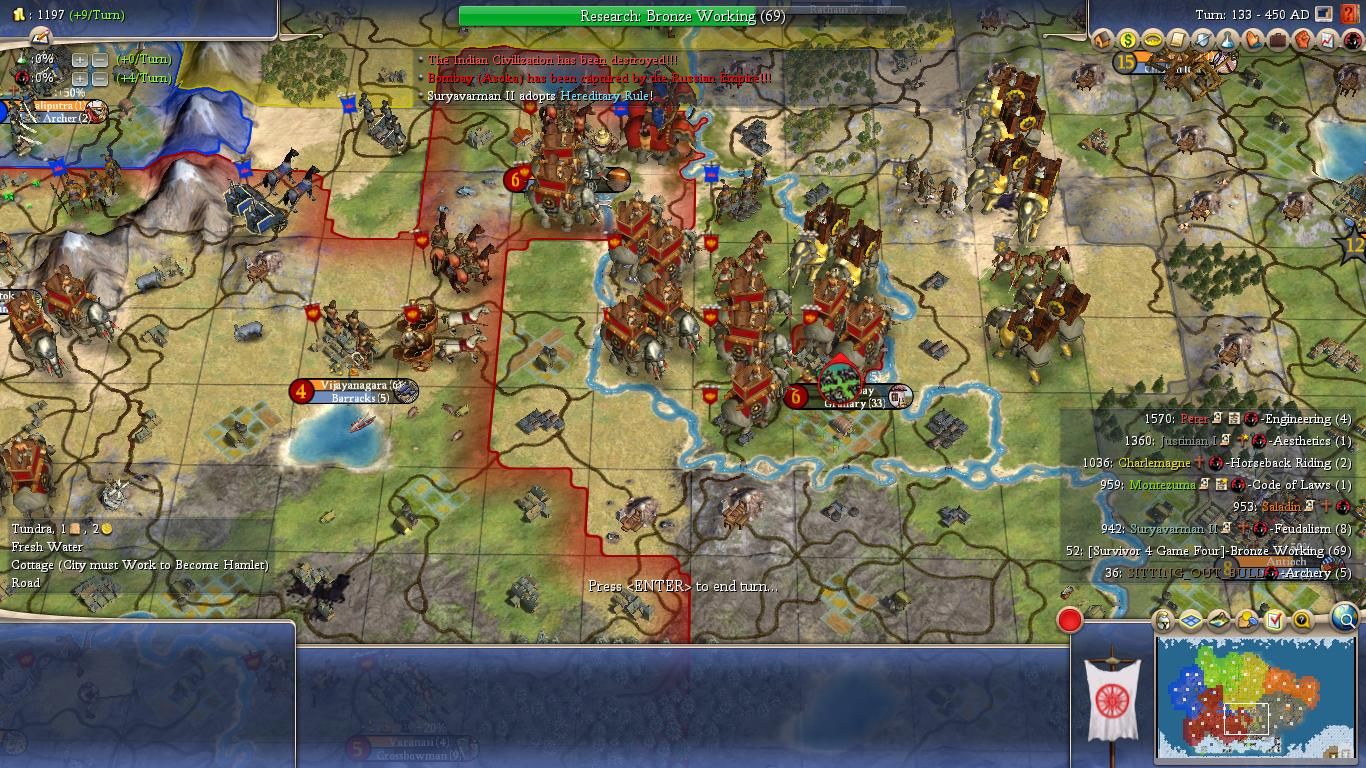
RIP Asoka, you never had much of a chance on this map and you did everything possible to make your situation worse. Capturing four Indian cities along with their treasure trove of wonders and shrines had shaken up the game situation. Now it was Peter topping the scoreboard and in a position to potentially snowball things further if he could pick off a weak neighbor. Suryavarman's situation looked precarious to say the least, with two Confucian civs bordering him to the east. With that said though, there were four total Christian civs against two Confucian ones, and Justinian also controlled the Apostolic Palace. If the Byzantines could wield the power of their religious alliance successfully, then they still had a real shot to win this match.
Worldwide peace didn't last for very long as Saladin initiated a war against Montezuma on Turn 139. This was one of those conflicts that doesn't make any sense from a strategic standpoint, but does make sense when viewed through the lens of in-game diplomacy and peace weight. Saladin and Montezuma were the two weakest leaders in the game by this point, and their struggle would largely serve to tie them up with ineffectual warfare that threw away units to no point. It did keep the two of them out of the larger struggle developing to the south, however. Justinian attacked Peter on Turn 153 and he pulled in his Christian allies on the next turn:

This was not the Apostolic Palace at work, as there was no resolution voted upon and Saladin remained locked in his pointless war with Montezuma. It was simply Justinian getting his Christian bros to join him in a crusade against godless Russia (quite literally: Peter was running Free Religion). When Justinian started researching Guilds a few turns later, it appeared that he had engineered a masterful bit of diplomacy. Setting up a 3 vs 1 war against his biggest rival right when cataphracts were popping onto the scene? Beautiful stuff. But Peter was the strongest leader on the board at this point and he wasn't about to go down without a fight. He started out by trying to break up the Christian coalition, getting a separate peace treaty with Charlemagne on Turn 159. This was a big help as far as reducing his opponents down to just the Byzantines and the Khmer. Make no mistake, this conflict was putting a major hurting on Peter:

Look at that bar graph plunge when everyone teamed up against the Russians. Peter had been on the verge of running away with the game before Justinian muscled his Christian coalition into a joint war. Instead Peter now seemed to be the one on the decline, and Justinian took the former Indian city of Bombay with its double shrines using the first wave of cataphracts. Were the Byzantines about to roll over Russia and seize control of the game? Apparently not: Justinian signed a peace treaty after taking that one city, leaving most of the Livestream viewers flabbergasted. How could he do that? Everything was set up for the Byzantines and then they sabotaged themselves at the last minute! Classic AI behavior. 
This left Suryavarman alone in his war against Peter after that rather callous betrayal from Justinian. The Russians were still the strongest civ on the board and things looked dire for Suryavarman, however we didn't see the immediate steamroll that the viewers had been expecting. Peter was gassed from all that fighting and needed time to build up his forces again. The single Khmer city in the middle of Russian territory continued to defy logic by remaining in Suryavarman's hands, and he even managed to capture a city deep in Russian territory away from Peter. For the moment, the Khmer were holding their own. Then we had this bit of craziness via the Apostolic Palace:
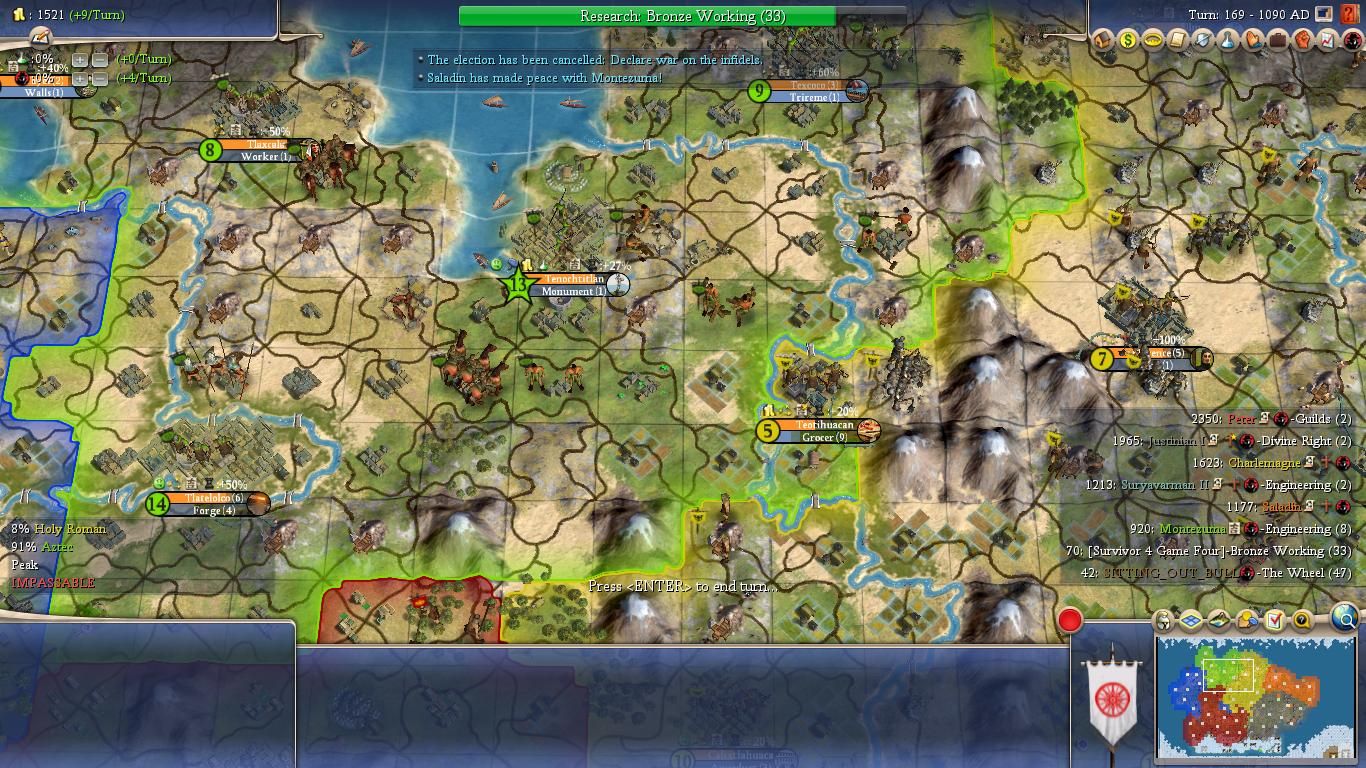
As always with the Civ4 event logger, read the messages from bottom to top. Justinian called for a "crusade against the infidels", which would have forced every other civ in the game to declare war against Montezuma. These can only be launched against civs that don't have the AP religion present in any of their cities, which was a condition that actually applied here since Monty had been spending most of the game in Theocracy civic and denying Christian spreads. However, Saladin made peace with the Aztecs on the same turn that the resolution passed and that ended up canceling it. I don't know that I've ever seen this before, what a rare situation to pop up. Montezuma's doom was narrowly averted for the time being. With that said though, he remained in last place running a Confucian religion that everyone else hated in a mostly Christian world. I doubted that he would live to see the end of the game, and this sentiment would be borne out in time.
The beginning of the end for the Aztecs started when Montezuma declared war on Charlemagne on Turn 175, all of half a dozen turns after his last war ended. This was the second time that he invaded the Holy Roman Empire, and this attack was significantly more ill-conceived than the first one. Charlemagne was considerably larger and stronger than Monty, and he immediately began capturing Aztec cities. In fact, if the HRE could take over all of the Aztec cities, there was a decent chance that Charlemagne could emerge as the game leader. Instead, Justinian called another AP vote to declare war on the infidels, and this time there was no convenient peace treaty to save Monty:
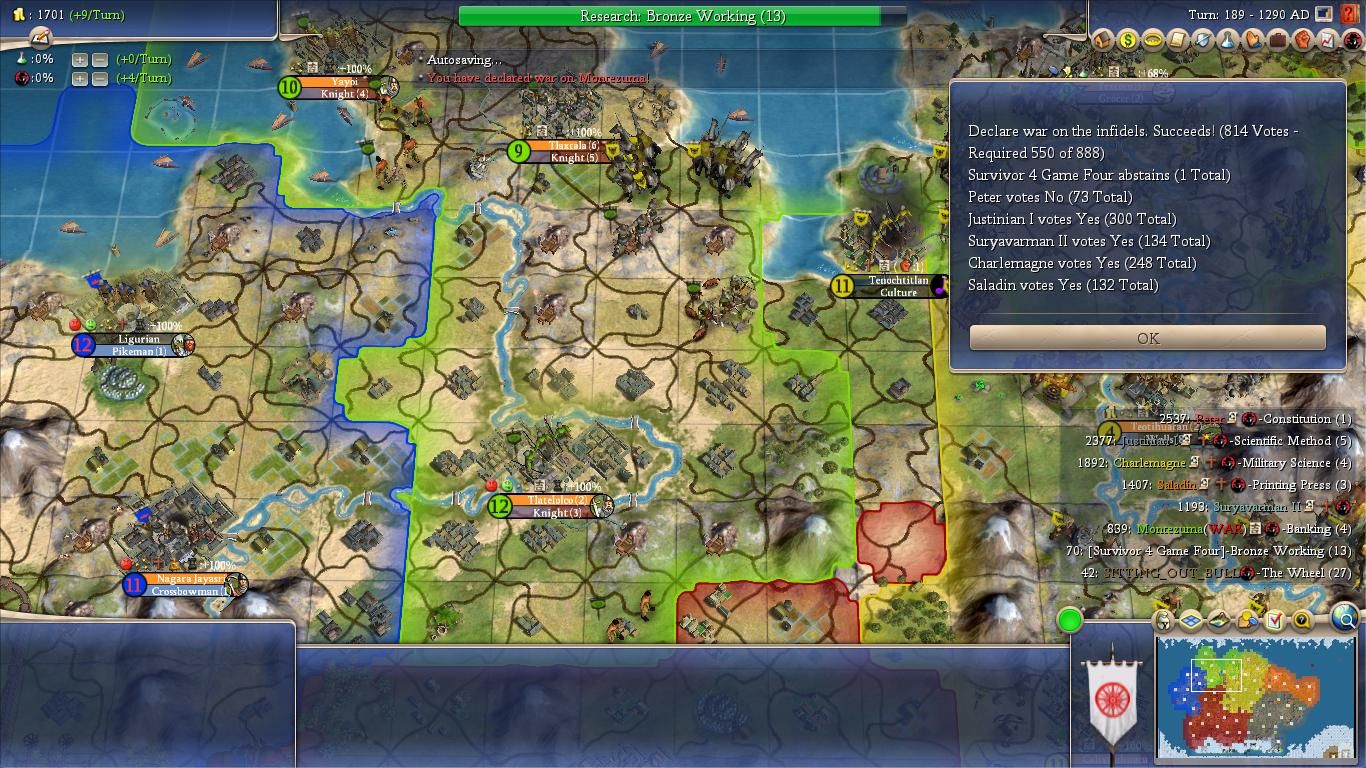
There's the Apostolic Palace resolution in action, with our new ability to see the votes taking place in Season Four of AI Survivor. Thanks to AI observer civ "Sitting Out Bull" for making this happen! Anyway, the net result was everyone else in the game declaring war against Montezuma: Justinian, Suryavarman, Saladin, Peter, and even the observer civ (which we did not count via the war counter). We ended up with this hilarious diplomatic screenshot of everyone hating and warring with Monty. For the millionth time Montezuma had started wars that he couldn't win and ended up with everyone detesting him. One city after another fell as the Aztecs were torn apart by the Apostolic Palace coalition. Saladin ended up with one random city far away from his homeland, Justinian picked up two cities, and Charlemagne got the rest along with the kill credit:

It was a deserved finishing blow for Charlemagne who had done more than anyone else to ensure Montezuma's demise. It was hard to feel sorry for the Aztecs who had reaped their own just desserts yet again. In the wider game context, the elimination of Montezuma came as bad news for Peter. Even though the Russians remained in first place for the moment, Justinian's alliance of four Christian civs spelled danger for Peter in the long run. It felt like it was only a matter of time before a new coalition formed against Peter, and he was not nearly strong enough to take on four opponents at once. At least the Apostolic Palace crusade trick wouldn't work against him, as there was Christianity present in several Russian cities.
The best thing that Peter could do to improve his situation would be conquering the Khmer. Their long-running war still continued, and despite the improbable successes that Suryavarman had enjoyed earlier, the weight of numbers was finally beginning to take its toll. Peter recaptured his lost city and then stamped out the one Khmer city in the middle of the map. It was a miracle that it had remained under Suryavarman's control for so long given the impossible strategic circumstances over there. Peter was now beginning to press into the Khmer core in earnest, capturing a border city and advancing on the capital. That was when Justinian intervened again to save his Christian brethren:
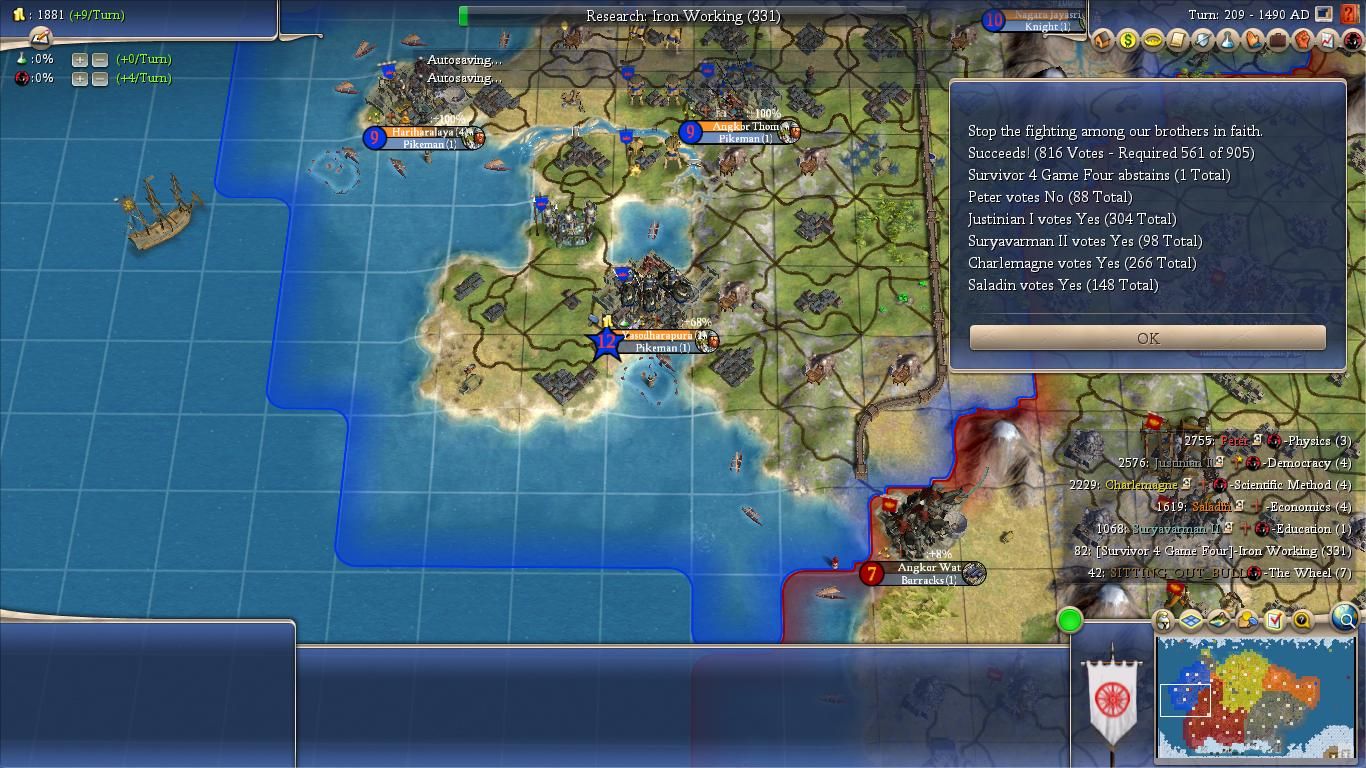
The Apostolic Palace forced an end to the war with all of the Christian leaders voting yes. Peter theoretically could have "defied" the resolution and kept the war going yet chose not to. A little while later, Justinian then used the AP once again to "return a city to its rightful owner" and had Angkor War reassigned back to Suryavarman once again. As obnoxious and infuriating as this war for Peter, it was also a true masterclass in the use of religious diplomacy by Justinian. He had successfully wielded the power of his Christian coalition to frustrate Peter's ambitions time and time again. One small crack in the Christian alliance had developed, however, as Saladin founded one of the late religions and eventually converted to Taoism. This meant that he lost all of the shared faith bonuses with Justinian, Charlemagne, and Suryavarman, making an attack by one of them against the Arabs (or vice versa) much more likely.
Peter and Justinian continued to jostle one another in a bid for first place, running neck and neck on the scoreboard. This was a reflection of how Peter had been weakened by his long series of wars, with Justinian closing the gap. Charlemagne was also on the rise and sat a short distance behind those top two. Saladin was a good distance further behind, followed by Suryavarman who was merely trying to survive at this point. This was the overall game state when the next round of wars began with a double declaration:

Charlemagne successfully launched the first strike against Peter and took a border city on the first turn of his invasion, only to have Saladin start his own offensive up in the ex-Aztec lands. Peter was ahead in tech and about to finish Rifling which seemed to bode poorly for Charlemagne. However, Justinian was finishing the Statue of Liberty and about to complete his own Rifling research (after going all the way to Biology first). He joined the war against Peter three turns later and Suryavarman piled in as well. The Christian coalition had been reassembled and Peter was back to the 3 vs 1 nightmare from earlier in the game. This was the beginning of the end for Peter, as Saladin was too far away and too weak to serve as an effective partner. Fighting against Justinian alone would have been a difficult task for Peter; facing Charlemagne and Suryavarman as well was too much to ask. Russian cities began falling one after the next, and the power bar graphs served to tell the larger story. Justinian was ascendent, Charlemagne was riding his coattails as a powerful junior partner, and Peter was on his way out of the game.
The dismantling of Russia proceeded in clinical fashion over the next 50 turns. No one signed peace to give Peter a reprieve and one city after another fell methodically to the invaders. The Byzantines made the most gains but not in lopsided fashion, with Charlemagne landing more than his fair share of the spoils. Given the fact that Charlemagne was also fighting Saladin at the same time, he was taking more Russian cities than most of the viewers expected. Even Suryavarman managed to take one city despite using medieval units against everyone else's rifles and cavs. The struggle arrived at its final conclusion on Turn 277 with Justinian delivering the final blow:

Peter spent most of the game atop the scoreboard and truly had been in a position to become the runaway AI after he devoured all of the Indian lands. However, he found himself on the outside of the Christian bloc that developed in this game, and that eventually proved to be his undoing. Montezuma was the other outsider AI who never flipped to Christianity, and once he was gone there was no one else to provide much aid to Peter. Strong as he was, he couldn't compete with the three-way united Christian team. Their unity had been the story of this game.
Saladin was the last one remaining outside of that tripartite alliance, largely because he had also been part of Team Christian for much of the contest. The decision to switch over to Taoism was a huge mistake and Arabia appeared to be the next civ on the chopping block. Fortunately Saladin managed to secure a peace treaty with Charlemagne on Turn 279, although not before losing the Arabian colonies in the west and a core city along the Holy Roman border. At this point it looked like we might have a peaceful space race finish, as Justinian and Charlemagne and Suryavarman were all "Friendly" with one another and would never attack their partners. However, Charlemagne still carried a grudge from the earlier invasion of the Arabs, and he decided to finish things off on Pi turn:

Saladin had little chance to survive in this war. No one was going to come to his rescue and he was woefully behind in production capacity and land area, if surprisingly equal to Charlemagne in technology. Saladin needed to hope that Justinian would vote through a "stop the war" resolution in the Apostolic Palace, or perhaps in the United Nations which Justinian was in the process of building. It quickly became clear that Saladin would not live long enough to see a Byzantine spaceship victory, which was still two to three dozen turns from completing. The western half of Arabia was in the process of disintegrating and Holy Roman tanks were beginning to appear on the scene. With three cities still holding out, there was one last hope: Justinian called for a Diplomatic Victory vote in the United Nations. Justinian and Charlemagne would split the vote, but Suryavarman might vote for Justinian given their +10 relations. It was going to be very close even if the Khmer cast their votes for Justinian. Would it be enough?

Yes it was! Diplomatic victory by a whisker, Justinian winning by a narrow 8 votes. If Suryavarman had not captured that one Russian city, or if he hadn't planted that icy tundra settlement in the deep south, Charlemagne would have had enough votes to block the victory and Saladin would have died. Instead, Saladin joined Suryavarman in heading for the Wildcard game, with the top two leaders going to the playoffs. This was a deserving end to a game that had been defined by religious diplomacy from start to finish. Justinian's skillful use of the Apostolic Palace and his Christian allies were what allowed him to stop Peter from running away with the game, and ultimately engineer the defeat of his great rival. And just as Justinian had used the Apostolic Palace to save Suryavarman from certain defeat by Peter earlier in the game, Sury paid him back by voting Justinian into the winner's chair in the United Nations. This was a game that was won with the pen and the miter, not the sword. It was also a fantastic result from a wider AI Survivor perspective, as we ended up with one Domination win, one Cultural win, one Spaceship win, and one Diplomatic win among the first four contests. Good job not making that a boring picking contest entry, AI competitors!
This was a fascinating game to watch due to the heavy importance of religion. The diplomatic messages of "Civ X has converted to Christianity!" were as important in this game as the war declarations. I think the biggest swing in the game came from Suryavarman randomly converting to Christianity in the early stages. If he had picked up Confucianism instead, the more logical religion due to its close proximity, this would have turned into a completely different contest and Peter likely ends up winning it. The constant presence of the Khmer served to hamstring Russia in this game and stopped Peter from running away with things. Instead it was the Christian group that had the numbers to come out victorious. All of them survived while all of the non-Christian civs were eliminated (or were about to be eliminated). In the end, Justinian proved to be the best leader at surviving and even thriving in the wars of religion.
* * * * * * * * * * *
Over a year after Season Four concluded, Wyatan decided to rerun the Season 4 games, 20 times each, and publish the results. The objective was twofold:
- See how random the prediction game actually is. There's a natural tendency when your predictions come true to go "See! Told you!", and on the contrary to dismiss the result as a mere fluke when things don't go the way you expected them to (pleading guilty there, Your Honour). Hopefully, with 20 iterations, we'll get a sense of how flukey the actual result was, and of how actually predictable each game was.
- Get a more accurate idea of each leader's performance. Over 5 seasons, we'll have a 60+ games sample. That might seem a lot, but it's actually a very small sample, with each leader appearing 5-10 times only. With this much larger sample, we'll be able able to better gauge each leader's performance, in the specific context of each game. So if an AI is given a dud start, or really tough neighbours, it won't perform well. Which will only be an indication about the balance of that map, and not really about that AI's general performance. But conversely, by running the game 20 times, we'll get dumb luck out of the equation.
These were the results of Wyatan's investigation of Game Four from Season Four. This match saw Justinian play a perfect diplomatic game, where he leveraged his Christian alliances and the Apostolic Palace to curb and eliminate his rivals. It also saw Charlemagne ride Justinian's coattails to the playoffs, which ultimately would allow him to claim that season's title. We've got ample proof that Justinian is a strong leader, but how much of that owes to his masterful use of the AP? And although Charlemagne would also reach Season Five's Championship game, was his second place behind Justinian in this game deserved or a fluke?
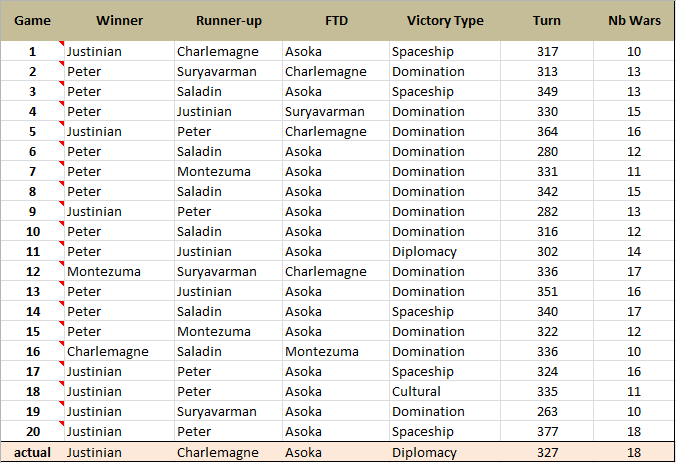
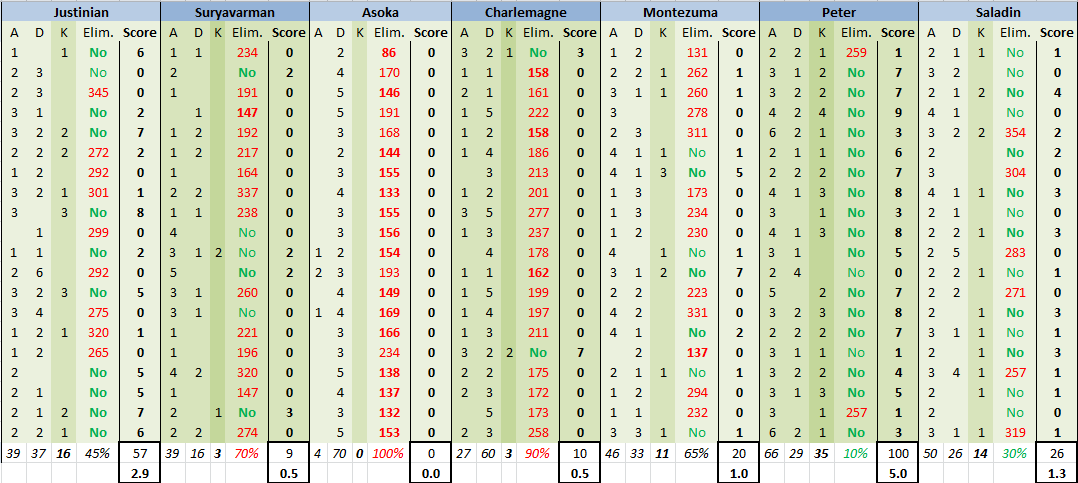
(note : "A" column tracks the number of war declarations initiated by the AI, "D" the number of times the AI is declared upon, "K" the number of kills)

The first game I played yielded the same result as the actual competition game: Justinian wins, Charlemagne comes second. And then the narrative completely changed.

Justinian of the Byzantines
To no surprise, it would seem that yes, removing the Apostolic Palace from the game did hurt Justinian a lot. Thanks to the turn order advantage, he would always get an initial religion (except for one game where he opened instead with a worker tech). He also almost always was first to Theology, so the AP would have been consistantly his. He was a strong performer here, winning 7 games (4 of which being the last four games I played)... but Peter was just stronger on this map. Justinian had quite a few things going for him: a strong capital with two food ressources and a gold tile, the most land to expand peacefully out of all AIs, an easy conquest option with Asoka, a generally safe neighbour with Saladin: in most games, Saladin would pick up Justinian's religion and remain a steadfast ally, and no Financial leader in the game, allowing him to leverage his shrines into a tech lead (by virtue of enabling a higher science slider). But with so many religious-focused AIs in the game, he wasn't able to form a dominant coalition. And without the AP, he couldn't bend it to his will. Those games also seemed to reveal a glaring weakness in the Justinian AI: with its heavy religion emphasis, it would often get a perfect setup for an cultural win... and it never went for it. Pulling the slider just doesn't seem to be part of the Justinian package, and that cost him several games.

Suryavarman of the Khmer
The Khmer leader was one of the worst performing AIs here, getting the second worst total score (below even Charlemagne's, but surviving more often). But I believe the map explains most of it. Suryavarman got a coastal start. Now, coastal starts are often deemed bad for the AI when they don't have Fishing tech for obvious reasons, but I believe that the main issue is that, by definition, they provide no backline. And that was clearly the case here: the Khmer would cram 6-7 closely packed cities in their corner of the map, and be out of options. It also didn't help that half of that land was covered in jungles, and that they had no early happiness ressource. Actually, they had one gold tile, at a very good city site... which they never prioritized, heading deep into the jungle first. So that part was on them. But essentially, they would try to break out (39 wars declared), and fail (3 kills only), ending up being conquered instead. By Russia, mostly. Suryavarman's role in this game was to grow future Russian cities, and in that respect, he succeeded admirably.

Asoka of India
Oh boy. He has died in every single game, been first to die in 15 out of 20, managing to launch 4 attacks while being attacked 70 times. That was a marked man, there. High peace weight AI, in the center of map, with a high religious emphasis, in a game where the only other high peace weight AI was also a religious zealot who would usually run a different religion. Not much to say, really. The writing was on the wall for him, and there simply was no surprise. To make matters worse for him, his land had very little hills: most of his cities (and all of his core cities) were on flat ground, and production-poor. There were two oddities I noticed. On several occasions, he was attacked when all he had to defend himself were archers. It wasn't that he hadn't metal ressources. It wasn't that he hadn't researched the relevant techs. He just hadn't bothered to connect those tiles. I don't know what could cause that, but there were also several occasions were he focused his military exclusively on Peter, with one particularly egregious case where he had 4 archers defending his capital with two foreign main stacks converging on it, and more than twice that amount of defenders in border cities with Russia that were under no threat. Anyway, at this point, I think we have enough data for a very simple rule: If India starts in a corner of the map, we have a contender for the win. If India starts in the center of the map, we have the grand favourite for first to die.

Charlemagne of Holy Rome
Charlemagne haters rejoice: his making it out of that game was a complete fluke. He has the worst survival rate after Asoka, getting killed in 18 games out of 20. Most games followed a scenario where Asoka died first, and Charlemagne was next. It's perfectly logical actually: Charlemagne's situation was basically the same as Asoka's. A high peace weight zealot in the middle of the map. Asoka's peace weight is higher, making him the priority target, and his direct neighbours were the strongests AIs on the map (Peter and Justinian), so that explains why Asoka went down first. And contrary to what happened in the actual competition game, he would more often than not follow a different religion than Justinian. To Charlemagne's credit, although he faced a lot of situations where he was attacked from two different sides (by Monty and Saladin), it usually took one of the game leaders to get involved for him to succumb. And he did win a game. He had two good games only, and both followed a similar scenario where Charlemagne launched an early offensive against a metal-deprived neighbour, and could snowball from there. But his rightful place in Season 4's rankings was way down at the bottom. Certainly not at the very top.

Montezuma of the Aztecs
We don't expect crazy Monty to be a strong performer, and that was confirmed here too. He did manage to get 11 kills, and he had two strong games, actually winning one. But while he did better than Asoka, Charlemagne, or Suryavarman, that still wasn't exactly a strong showing either. After watching a few games, it did surprise me a little, though: he usually expanded well, he had two weak direct neighbours (boxed-in Suryavarman and dogpile bait Charlie), so why wasn't he doing a bit better? So I paid close attention to what he was doing in one game (game 15), and that brought some answers. First, he's just bad. On turn 30, he had improved a single tile! No easy access to copper: a warmonger's successful game relies on hitting a weak neighbour fast and hard, and Monty's metal situation did not allow for it. A lack of early happiness ressources: the only one was a Gems tile in the jungle to his south (and "jungle" means that "early" doesn't apply). Also, contrary to Justinian for instance, Monty is very bad at spreading his own religion, so he would often find himself in a delicate diplomatic situation once Asoka and Charlemagne were gone. And his teching is usually just awful. I've seen a 10-city Montezuma researching Education... on turn 300!

Peter of Russia
I expected Justinian to dominate this game... Peter turned out to be the strongest leader here. It comes as a semi-surprise: in the actual competition game, Peter rose to a game leading position before Justinian could orchestrate a dogpile on him. And while the Apostolic Palace wasn't involved in the first war which prevented Peter from running away with the game, it was instrumental in his subsequent downfall. I believe Peter to be a somewhat underrated AI. Let's get this out right away: no, he's not a top AI. But he's a competent AI. Good enough to thrive if dealt a good hand, but not good enough to make do with a bad hand. Take his season 5 games. In the first game, he was given a very strong capital, with much weaker but abundant surrounding lands. And while the main story of that game was Alexander conquering the world, the subplot was a fight between Peter and Justinian (again!). And Peter won that fight. When Alexander's armies came down and swept away the remnants of the Byzantine Empire, Justinian was already on the ropes and going down. So Peter deserved his second place there. But in the playoff game, he was given a tundra start between a monstrous Gilgamesh and Huyna Capac. And he failed miserably.
So was he given that good of a hand here? His starting land has two early happiness ressources (Ivory + Gold, although a running gag was that he keeps settling his cities in such a way that he couldn't work the Gold), Stone (which he put to good use by usually building the Pyramids and running an early Representation). He had rivers for bonus commerce, and a coastal site with 2xFish, Clams, Cows, and Horse (certaintly an original starting position that Sulla left as is, without weakening it). But there were also a lot of "brown" tiles, and he would fast run out of decent city sites and have to settle tundra spots. So all in all, slightly better than average, but nothing to write home about? It wasn't so much the land as his position: he was neighbouring Asoka and Suryavarman. Asoka would always face a dogpile, and Peter would be part of it, getting a few extra cities that way. That would help, but Suryavarman was the real boon: the Khmer were weak in nearly every game, and get into a fight with the Russian. A fight that would end with them being conquered. And contrary to the Indian case, Peter wouldn't have to share. He'd get the whole of the Khmer cities. And that would be enough to propel Peter into a game-leading position.
With Growth and Science as his research flavours, he would also turn his size into a research lead, and get unstoppable from there. It should be noted that Justinian's religious spreading often backfired: Justinian would usually be stronger than Peter before the Russians could absorb the Khmer, but they would be religious allies at that point (with bonus points for the shared conquest of India). Then Peter would get stronger, drop into Free Religion, and turn around on Justinian. Something I didn't expect: Peter's also a member of the Rifling-tech eschewing club. In spite of having a unique unit unlocked by that tech. It usually wasn't that much of an issue (essentially just slowed his conquest), but he paid dearly for it in one instance at least (game 16). We've focused on cases like Willem, because it's frustrating to see an AI get into such a tech lead that they have the game in the bag, only to throw it because they won't research the one tech that would make them safe, but I think it's actually much more prevalent than that: basically any AI that doesn't have "military" as a research flavour will delay researching Rifling. All in all a very strong showing by Peter, who actually was on a course to end up with a Caesar-like score, before weakening in the latter half of the games. He does finish at 100 points, which remains a very impressive score. And with 35 kills for 66 wars declared, he equals Caesar's 53% lethality rate.

Saladin of Arabia
Saladin had mostly... quiet games? He has the best survival rate after Peter, surviving 14 games out of 20. He was also the most likely to end up second (although at 30%, that's a weak favourite, as illustrated by the fact the "best bet" has betting on Justinian as the runner-up for the reverse order points instead of backing Saladin). He never won, getting into a winning position only once but failing to exploit it. His usual game involved getting Justinian's religion and staying his ally to the end, fighting Charlemagne at some point, and subsequently laying low. As a leader who cannot plot at pleased, he was basically neutered whenever Justinian managed to convert the world. His expansion was blocked to the west by Holy Rome, and to the south by the Byzantines. The jungle area to his south east was often key: if he could get it, he'd stay relevant. If Justinian got it, he would become very strong, while Arabia would stay a stunted civ. I guess he was in a similar position to Suryavarman's: a coastal start, with half of his available land covered in jungles. The crucial difference in their games being their relation with their big neighbour. So, for the most part, he played the role of Justinian's sidekick, and that was basically it.

Finish date and Asoka FTD went according to expectations. Justinian winning wasn't the most likely result, but not a complete outlier. Charlemagne runner-up and victory type were extremely flukey (Diplomatic victory always is).



